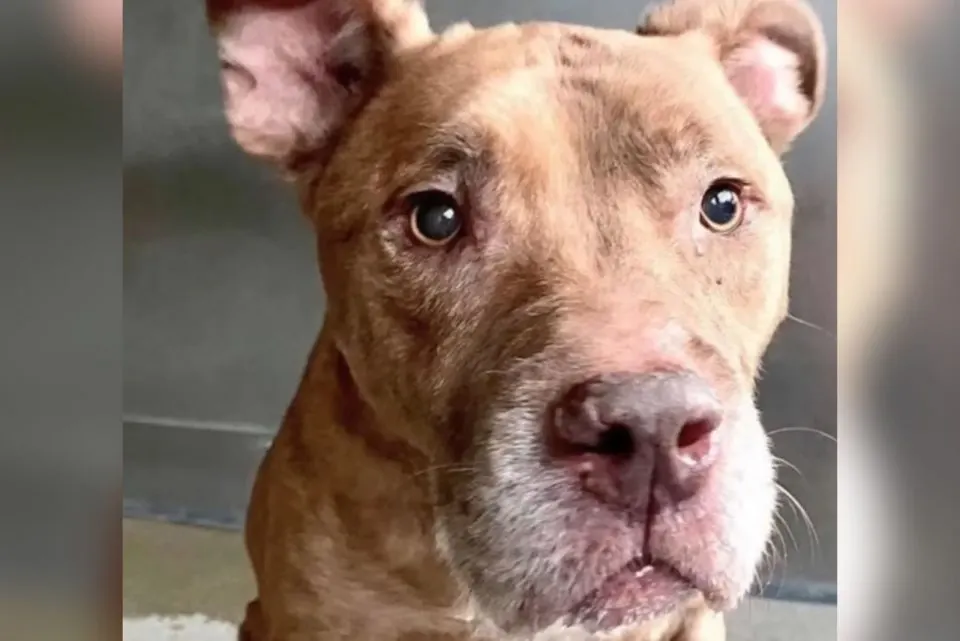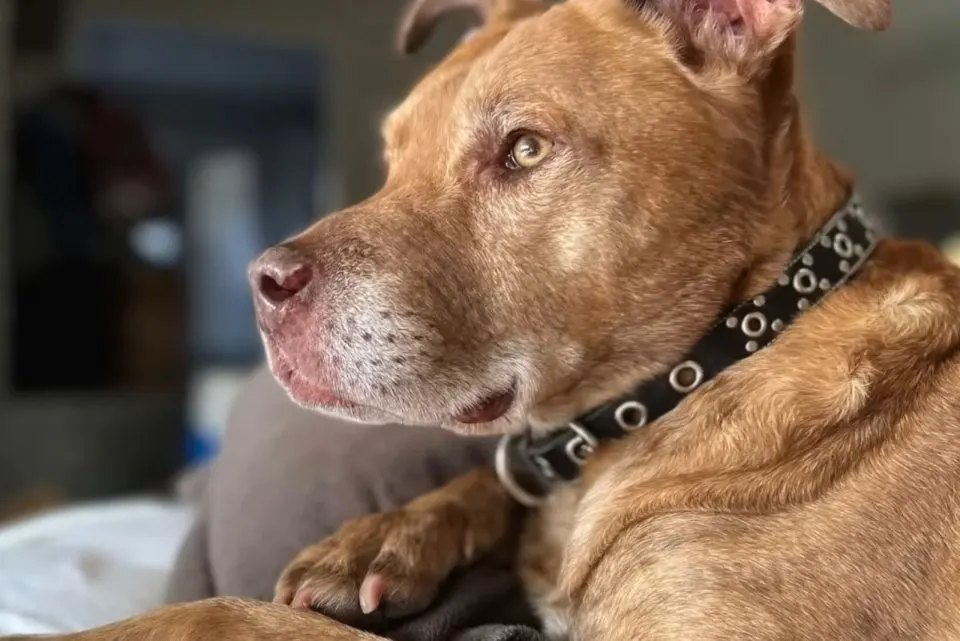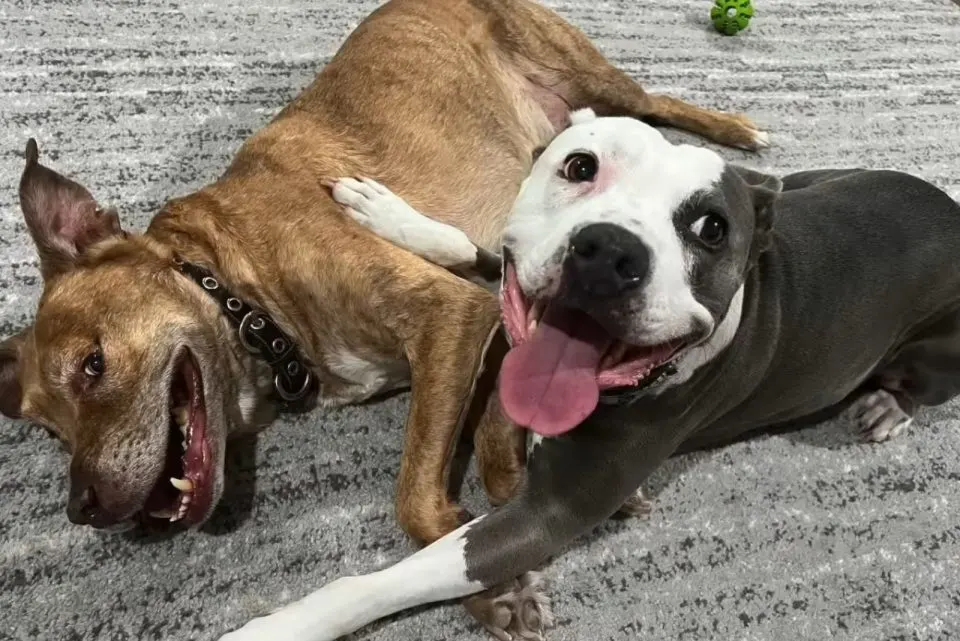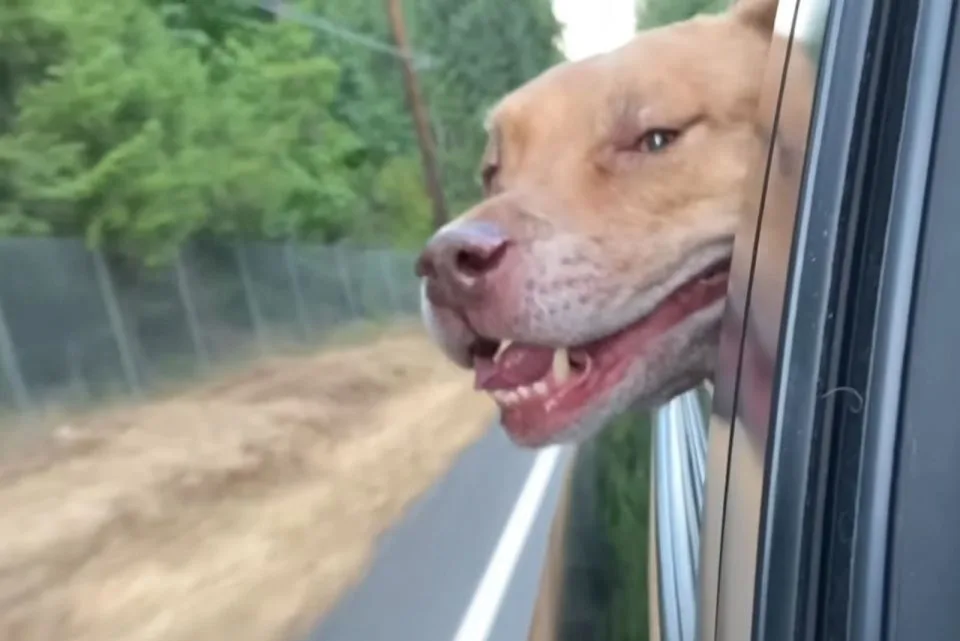Leo had too much burden on his back.
So many troubles, but so little time has passed under his paws.
He grew old too soon. The grey hairs around his face did not give him a distinguished gentleman’s look. He became a tired gentleman… too tired of life, without any will to continue.
Leo gave up.
But, what Leo didn’t know was that someone out there did not give up on him.
While his shelter buddies were going to their furever families, Leo stayed put, watching them go with tears in his eyes.
Soon enough, this poor old pal found himself feeling numb for everything, even for food and water.
The change was about to enter Leo’s life in the most pawtacular way.
He’s Not That Old After All

Senior dogs always get overlooked by potential adopters. No one really wants an older dog with an expiration date, and that’s the ugly truth.
But, sometimes people should look past these etiquettes and offer second chances. Sometimes, eyes can’t see very well what’s lying before them.
When Deanna saw Leo at her local Texas shelter, she read everything from his sad eyes. Leo did not have any strength left in him to keep on fighting.
But, Deanna had an ace up her sleeve: her kindness and her other Pittie, Kallie.
Leo and Kallie immediately clicked. It was like she brought him back the spark in his life.
You can say the rest is history because this poor, rejected Pittie got home that day with Deanna and Kallie.
Leo got the home he was always deprived of.
But, Leo didn’t leave the shelter without anything with him: he was carrying a secret surprise.

Although the shelter thought he was about 10 or 12 years old, it turned out that those grey hairs were just some fashionable accessories.
Leo was five when Deanna adopted him! He deceived us all but in a good way. This meant there was much more time left for Deanna, Leo, and Kallie to hang out together.
Life couldn’t be sweeter!
Learning How To Dog

Unfortunately, Leo was not like other dogs. I say unfortunately because he did not know how to behave like a dog. Apparently, Leo was a back yard dog, never cuddling or playing with anyone. He lacked human attention and affection throughout his life.
Well, good thing Deanna was there to shower him with love, and his big sis, Kallie, was eager to show him the art of dogging.
Getting used to being an indoor dog was ruff. Leo never saw a dishwasher, nor his reflection in something shiny.
He didn’t even know how to play with toys! But, he did know how to appreciate small things like comfy beds and warm blankets, and he always tried to show how grateful he was.

Little by little, Leo opened up and started acting like a true doggo. He even got to enjoy car rides – his favourite thing of all!
What Deanna didn’t realize at first was that Leo did come with a couple of other surprises that showed he was indeed an older soul trapped in a young dog’s body. For example, Leo came to them with arthritis in all of his limbs.
Further examination showed that Leo also needed knee surgery – on two of his knees, to be precise. These health issues were all because Leo was once kept as a backyard dog, definitely chained up and without proper nutrition and an exercise routine.
Another reason why I can’t stress enough about how important exercising is for dogs.
If you’ve ever noticed your furry friend scratching incessantly, chances are they might have picked up some unwanted hitchhikers – fleas. These tiny, pesky critters can quickly become a nuisance for your pup, causing discomfort and irritation. But have you ever wondered how exactly dogs end up with these bothersome bugs? Understanding the source of the issue is the first step in effectively tackling it.
As a seasoned dog enthusiast, you know that fleas are not just a problem for your pet but can also impact your entire household. From outdoor adventures to interactions with other animals, there are various ways your canine companion can attract these tiny pests. By unraveling the mystery of how dogs come into contact with fleas, you’ll be better equipped to safeguard your four-legged friend from these persistent parasites.
Understanding Fleas on Dogs
Fleas are common parasites that can infest your furry friend and make their life uncomfortable. These tiny insects can quickly multiply and cause itching, scratching, and skin irritation in dogs. Understanding how dogs get fleas is crucial to prevent and manage infestations effectively.
1. Contact with Infested Animals
When your dog interacts with other animals infested with fleas, there is a high chance of these pesky critters hitching a ride back home on your pup’s fur. Playdates at the park or encounters with stray animals can lead to flea transmission.
2. Environment
Fleas thrive in warm and humid environments. Your dog can pick up fleas from infested areas like grass, carpets, or outdoor spaces, especially in the summer months when these parasites are most active.
3. Lack of Preventive Measures
Not implementing flea prevention measures increases the risk of your dog getting fleas. Regular use of flea prevention products recommended by your veterinarian can help keep these pests at bay and protect your furry companion.
4. Grooming Habits
Dogs with poor grooming habits or long, thick fur are more susceptible to flea infestations. Regular grooming, including baths with flea-repellent shampoos, can help prevent fleas from making a home on your dog’s coat.
5. Travel
Traveling to areas with a high flea population can also expose your dog to these parasites. Whether it’s a trip to a rural area or a visit to a friend’s house with infested pets, your dog can easily pick up fleas during travel.
Understanding the various ways dogs get fleas is essential for effective flea control and prevention. By being aware of these sources, you can take proactive steps to protect your beloved pet from the discomfort and health risks associated with flea infestations.
Common Ways Dogs Get Infected with Fleas
When it comes to your furry companion picking up fleas, several common scenarios put them at risk:
- Contact with Infested Animals
Meeting infested animals during walks or visits to parks can easily transfer fleas to your dog’s coat. Dogs are social beings and enjoy interacting with other pets, making this a common route of transmission. - Warm and Humid Conditions
Fleas thrive in warm and humid environments, making them prevalent during the summer months or in regions with this climate. Your dog spending time in such areas increases the chances of flea infestation. - Lack of Preventive Measures
Skipping regular flea prevention treatments leaves your dog vulnerable to flea attacks. Without protection, these pests can latch onto your pet and start an infestation. - Grooming Habits
Inadequate grooming practices can lead to fleas taking residence in your dog’s fur. Brushing and bathing play a crucial role in preventing fleas by keeping your dog’s coat clean and healthy. - Travel to Flea-Prone Areas
Visiting locations known for flea infestations poses a risk to your dog. Whether it’s a stay in a pet-friendly hotel or a visit to a friend’s house with a flea problem, traveling increases exposure to these pests.
Understanding these common ways dogs contract fleas empowers you to protect your furry friend effectively. By being aware of these sources of infection, you can take proactive steps to keep your dog flea-free and ensure their well-being.
Signs and Symptoms of Flea Infestation
If your dog has fleas, there are several signs and symptoms you can look out for to identify a flea infestation:
- Excessive Scratching: One of the most common signs of fleas on dogs is excessive scratching, licking, or biting at their fur. If you notice your dog is scratching more than usual, it could be due to flea bites.
- Red Patches on Skin: Flea bites can cause red, irritated patches on your dog’s skin. Check for any redness or inflammation on your pet’s body, especially around their neck, tail, and belly.
- Hair Loss: Severe flea infestations can lead to hair loss in dogs. Keep an eye out for any bald spots or patches where your dog’s fur seems to be thinning.
- Flea Dirt: Flea dirt looks like small black specks or grains of pepper on your dog’s skin or fur. To check for flea dirt, comb your dog with a fine-toothed flea comb over a white paper towel and look for tiny black particles that turn red when moistened.
- Pale Gums: In severe cases of flea infestation, dogs can develop anemia, which can cause pale gums and weakness. If you notice your dog is lethargic or has pale gums, it could be a sign of a significant flea problem.
- Visible Fleas: If you see small, dark, fast-moving insects on your dog’s fur, these are likely adult fleas. Adult fleas are typically visible to the naked eye and can be found crawling on your dog’s skin.
By recognizing these signs and symptoms of flea infestation, you can take prompt action to treat your dog and eliminate the fleas from your home. If you suspect your dog has fleas, consult your veterinarian for the best course of action to protect your furry friend.
Preventative Measures to Protect Dogs from Fleas
To safeguard your furry friend from those pesky fleas, follow these simple yet effective preventative measures:
- Regular Grooming: Brushing your dog’s coat regularly not only keeps it looking great but also helps you spot any potential flea problems early on.
- Use Flea Preventatives: Invest in vet-recommended flea preventatives such as spot-on treatments, oral medications, or flea collars to keep those blood-sucking pests at bay.
- Maintain a Clean Environment: Vacuuming your home frequently, washing your dog’s bedding in hot water, and keeping your yard tidy can help minimize flea habitats.
- Regular Vet Check-ups: Schedule routine vet visits to ensure your dog is healthy and flea-free. Your vet can recommend the best preventative measures based on your dog’s unique needs.
- Be Mindful of Other Animals: If your dog interacts with other pets, ensure they are also protected from fleas to prevent cross-infestations.
By following these preventative measures, you can create a flea-free environment for your canine companion and keep them healthy and happy.
Conclusion
That’s the lowdown on how dogs pick up those pesky fleas. Remember, prevention is key to keeping your furry buddy itch-free. With regular grooming, flea preventatives, a clean living space, vet check-ups, and watching out for other critters, you can keep those fleas at bay. Stay on top of it, and your pup will thank you with wagging tails and endless cuddles.
Frequently Asked Questions
Q: How do dogs contract fleas?
A: Dogs can contract fleas from other animals, outdoor environments, or coming into contact with infested areas.
Q: Why is proactive flea control important?
A: Proactive flea control is essential to prevent discomfort for the dog, potential health issues, and flea infestation within the home.
Q: What are the signs of flea infestation in dogs?
A: Signs of flea infestation in dogs include excessive scratching, red and irritated skin, hair loss, and visible tiny dark insects on the fur.
Q: Why is prompt treatment necessary for flea infestation?
A: Prompt treatment is crucial to prevent the infestation from worsening and causing more significant health problems for the dog.
Q: What are some preventative measures to protect dogs from fleas?
A: Preventative measures include regular grooming, using flea preventatives recommended by a vet, maintaining a clean environment, scheduling regular vet check-ups, and being cautious around other animals to prevent cross-infestations.
[no_toc]

Hey there, I’m Janet Brooks, a dog-loving student from California. I’m all about helping pups in need, especially those without homes. Me and my awesome friends work together to give shelter and love to stray dogs. Oh, and I also write blogs about dogs to share helpful info.